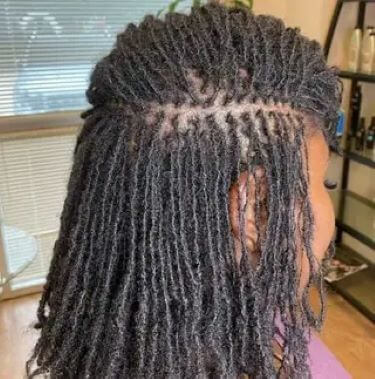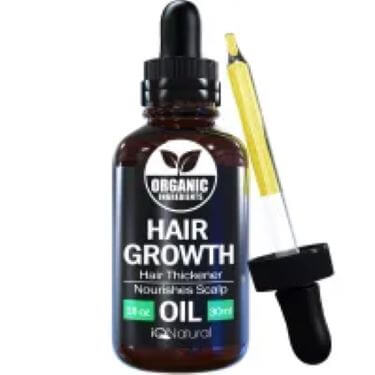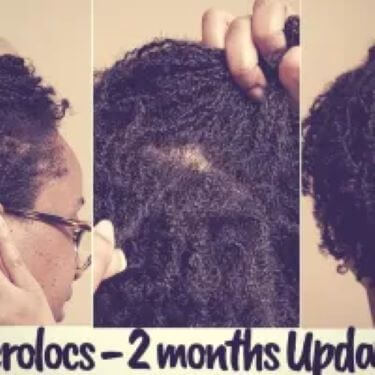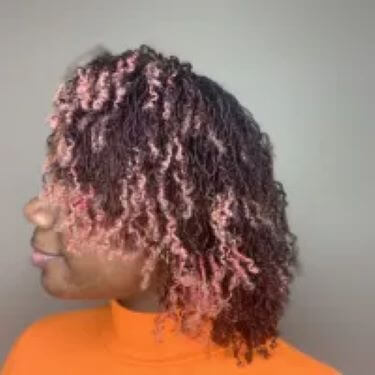Confused about microlocs maintenances? As one of the newest trends in dreadlocks, microlocs are taking the world by storm nowadays, yet some starters still hold doubts: How could they maintain their microlocs and with what posture should they sleep with them? This article might hopefully give you some answers.
Many people presume that it is a rather complex process to install microlocs. That is true, but microlocs maintenance is not an easy task either,which entails multiple aspects. The following section will give you some guidance on how to wash, oil, moisturize, retighten, style, sleep with and do activities with your microlocs.

Wash your Microlocs
Washing is an essential step in maintaining the health of your microlocs, especially when they are not mature yet. For example, you should choose the right hair product which suits your hair texture, and it is also important to deal with your locs with correct skills.
· First and foremost, please select a suitable shampoo. You are recommended to use a clarifying shampoo rather than a moisturizing shampoo, because a clarifying shampoo makes the cuticles of your locs become “rougher” than usual. In this way, it enables your hair strands to hold together.
This slight change in your hair texture can effectively prevent slippage, thus helping lock those microlocs. What’s more, a clarifying shampoo will prevent unnecessary build-up of grease and dust, thus keeping your locs and scalp clean and healthy. On the contrary, a moisturizing shampoo always functions as a lubricant for your hair, which usually leads to slippage.
· Braid your hair and then band it to prevent slippage. Before you wash your locs, please braid your locs in small sections (at least 10 sections, and you can also braid more if you have more locs) in order to keep the ends sealed. By doing so, your microlocs are less likely to be undone because they have been put in place.
· Wear a shower cap. A shower cap is a useful tool which can prevent excessive moisture from reaching your locs, because too much moisture might unravel your locs.

· Wait until your locs are completely dry, and then take out your braids. If you remove your braids too soon, moisture from the water will make your hair curl and shrink, and thus hinder the interlocking process at the end of your locs.
· Rinse your microlocs carefully. After using a shampoo, traces of shampoo might leave on your scalp. As most shampoos contain some chemical materials which will hurt your hair and scalp, it is consequently better to wash your hair thoroughly and remove all traces of shampoo.
· Towel dry your locs preferably with a microfiber towel. Keeping water staying on your locs will do no good to curl and interlock your hair, because moisture usually helps to undo your locs. What’s more, water is likely to increase the weight of your locs, which may add tension to your scalp and do harm to its health.
Oil your Microlocs
Many starters might neglect the significance of oiling, especially when they first have baby locs. To be honest, correct oiling both increases moisture and decreases the dryness of your hair. Furthermore, it can also provide suitable nutrients for your scalp, thus promoting the growth of your locs.
· You can use light oil to protect your scalp weekly. Your scalp and locs might be hurt due to changes in the environment, and it is necessary to provide them with extra care. Light oil differs from normal oil because it won’t contain too much unnecessary nutrients which may become a burden to your scalp.
· Try a hairlock growth oil which can help to reduce frizz and dryness. Another advantage of this oil is that it will promote your hair to grow quickly by providing necessary nutrients for your scalp. In other words, it encourages the metabolism of your hair, which is beneficial to its health.

· Massage the oil into your scalp. Scalp is essential to your hair’s growth, so it is vital to maintain its well-being. You are recommended to apply some scalp-oriented care products and learn some massage techniques. Both of them will help to build a sound environment for your locs’ growth.
Moisturize your Microlocs
Moisturizing is an important step in the styling process. If you are trying to design and style your microlocs, you had better spray some moisture on your locs, which can reduce dryness and make it easier to fiddle with your hair.
· Mist your hair with rose water or plain water. In the beauty industry, rose water is a handy tool because of its ability to reduce dryness and oil. As it also contains relieving essence, it can ease the itching of your scalp as well. If you do not have rose water, plain water is also acceptable because it could help reduce dryness.
· Take a water spray to mist your hair every morning and night. This is an essential step in the daily maintenance of your locs. When you mist your hair with the spray in the morning, it will provide water necessary to keep your locs moist during the day. In the night, do not forget to lightly mist your hair at least two hours before you go to bed, because your locs may lose water in the night and you had better create a moist environment for them.
· Use leave-in conditioner spray to deal with the dryness when your locs starts to swell. Swelling signals that your locs are experiencing dryness and need proper care. Leave-in conditioner spray is a product which combines convenience and efficiency. While using it, you will not only save the trouble of washing your locs, but also enjoy better care of your hair.
Retighten your Microlocs
Retightening is also known as retie schedule, and a lot of people perceive it as the biggest difficulty they need to overcome in microlocs maintenance. There is no denying that it would consume much time and energy, but it is also an essential step to keep your locs healthy and sustain them for a relatively longer time.
· The growing speed of your hair decides how long it takes to retwist your locs. It usually takes 4-8 weeks to redo it. You can estimate the development of your hair during this period of time and make a proper choice. By the way, remember to set aside 2-5 hours for each retightening.

· Compared with other forms of dreadlocks, the time you need to wait between two maintenance sessions is remarkably longer. If you have learned some interlocking methods, you can go anywhere before your next maintenance session. Nevertheless, you had better not miss the next session, because it will cause unnecessary problems to your locs.
Style your Locs
Some microlocs lovers have tried different stylings to pursue uniqueness, but please do not over style because it may bring much tension to your locs.
· Do not over style your microlocs. It is recognized that microlocs itself is a rather complex styling which would bring stress to your hair. If you further add another styling based on it, there is no doubt that your locs have to bear more tension. What’s worse, over-complicated styling may lead to traction alopecia.

· Do not color/dye your locs, especially when your locs are not mature yet. Dying or coloring products contain a number of chemicals, which are likely to alter your hair texture. If done in an improper way, coloring is likely to cause excessive bunching (especially with bleach). Furthermore, bunching could make it very difficult to retighten your locs because the bleach may cause your locs to bulge. All of these will bring a lot of discomfort to your hair and hinder normal growth of your locs.
· Do not wear tight styles/ponytails. When your locs are still in the “Newbie” stage, please do not wear tight styles. You can try some low manipulating styles if needed, but do make sure they are not too tight. Tight styles place much tension on your locs, and may cause them to fall off.
Sleep with Your Microlocs
When you are sleeping, your locs are particularly fragile because you are not aware of your posture. Bad postures may increase friction of your locs and make them frizzier.
· Keep your microlocs covered. You can cover your locs with a satin bonnet or a scarf. They will function as an isolating layer between your locs and bedding, thus reducing the friction between them.
· Sleep on a satin or silk pillow. High-quality bedding will not only provide a softer sleep environment, but also give your hair better protection. For example, silk is made up of protein fiber and has a smooth surface. Therefore, it can effectively decrease static problems and friction with your locs. In other words, the risk of getting tangled and fractured will be greatly reduced.
· Avoid pajamas or pets. For those who keep pets, please be careful that you should not allow your pet(s) to touch your locs. Your pet(s) hair may cause adverse reactions to your locs. For instance, they may bring bacteria to your locs, making your scalp itchy. What’s more, as pajamas are usually baggy, they may touch your microlocs and generate friction with them. Therefore, please choose soft and fine pajamas, or you can choose to take off your pajamas while sleeping with your locs.
·
Do Activities with Microlocs
In daily life, you might get involved in various activities, and some of them are related to sports. It is important to offer special care to your locs when doing sports.
· Braid or band your locs before you go to gym or do intensive activities. Just imagine how your locs bump up and down when you are running. These activities will not only loosen your hair root, but also add extra tension to your scalp. Both of them will weaken your locs.

· Wear a swimming cap to avoid chlorine saturation if you go to the swimming pool. It is acknowledged that chlorine is irritating to skin and hair. It will remove grease and oil, thus making your hair dry and rough. What is worse is that it might even cause your hair to fracture.
Additionally, do not forget to rinse thoroughly after swimming. After being immersed in water for a long time, you should remove all the chlorine deposits on your hair and scalp to keep them clean and healthy.
· Wait until your locs are fully dry, and then release your braids. When your microlocs are still wet, they are in a fragile state. If you fiddle with them, such as pulling, fracture and falling might easily happen. As a consequence, it is suggested that you should unravel your locs until they are fully dry.
Try To Make Your Microlocs Maintenances
After reading this article, you might have got a clear picture of how to do daily maintenance for your microlocs. There is no doubt that it is a time-consuming work which will cost you a lot of patience and time, but if you do like microlocs, this routine would be worth it. Hope you enjoy your microlocs journey!





